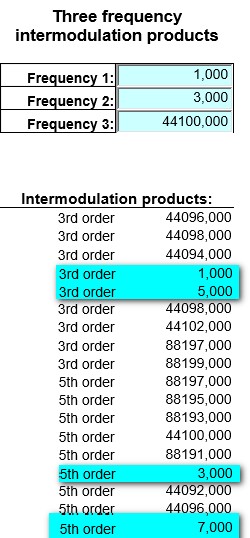Hi Al as you correctly confirms it is the output of the DAC, means it is exactly what I have described.
There are NOS (non-oversampling DACs) (I mean final products) on the market without any filter, they play signals like the simulation has shown!!!! that was the reason why I have written this paper to show my opinion that such a system is not useful. Obviously you have the same opinion. The Problem is not only that these sampling artefacts are above 20kHz, the real Problem is that amplifier with limited linearity will do a "down convolution" of this artefacts in the Audio band. Like you know from the Intermodulation distortion. Enclosed a simple calculation with the assumption that the Music is a 1kHz tone with a 3rd harmonic
The same can happen with the sampling noise of single bit Sigma-Delte converters, that means even if the noise is above 20KkHz it can happen that you can hear it as clear noise in the Audio band.
So sorry if I misunderstood your comment, but I am an engineer, if we speak about a DAC we mean a DAC IC and not the surrounding electronic.
To call a final product only DAC is the wrong phrases, since the final product contains in the most cases an active low-pass filter and a lot of other electronic.
TRINITY DAC does not need such an active low-pass filter caused by the LIANOTED architecture.
By the way as the CD was lunched they used analog brick-wall filters, since the DAC IC were not fast enough and digital oversampling filter were not available at that time.
Since you know we have a 16bit system and an audio bandwidth of 20kHz with a sampling frequency of 44.1kHz you can calculate the necessary order.
You need for a non-oversampling CD system a low-pass filter, which attenuates signals from 20kHz to 22.05kHz by 16bit x 6dB=96dB!!!!!
That is a very steep filter, which creates a lot of group delay Errors and so on.
There are NOS (non-oversampling DACs) (I mean final products) on the market without any filter, they play signals like the simulation has shown!!!! that was the reason why I have written this paper to show my opinion that such a system is not useful. Obviously you have the same opinion. The Problem is not only that these sampling artefacts are above 20kHz, the real Problem is that amplifier with limited linearity will do a "down convolution" of this artefacts in the Audio band. Like you know from the Intermodulation distortion. Enclosed a simple calculation with the assumption that the Music is a 1kHz tone with a 3rd harmonic

The same can happen with the sampling noise of single bit Sigma-Delte converters, that means even if the noise is above 20KkHz it can happen that you can hear it as clear noise in the Audio band.
So sorry if I misunderstood your comment, but I am an engineer, if we speak about a DAC we mean a DAC IC and not the surrounding electronic.
To call a final product only DAC is the wrong phrases, since the final product contains in the most cases an active low-pass filter and a lot of other electronic.
TRINITY DAC does not need such an active low-pass filter caused by the LIANOTED architecture.
By the way as the CD was lunched they used analog brick-wall filters, since the DAC IC were not fast enough and digital oversampling filter were not available at that time.
Since you know we have a 16bit system and an audio bandwidth of 20kHz with a sampling frequency of 44.1kHz you can calculate the necessary order.
You need for a non-oversampling CD system a low-pass filter, which attenuates signals from 20kHz to 22.05kHz by 16bit x 6dB=96dB!!!!!
That is a very steep filter, which creates a lot of group delay Errors and so on.









